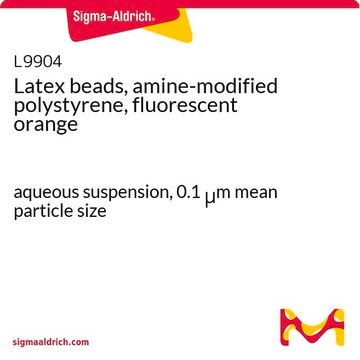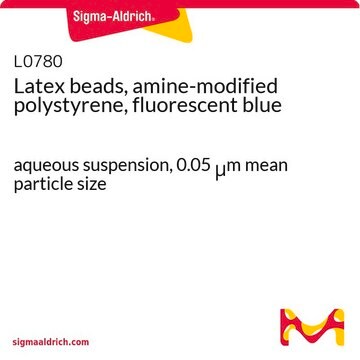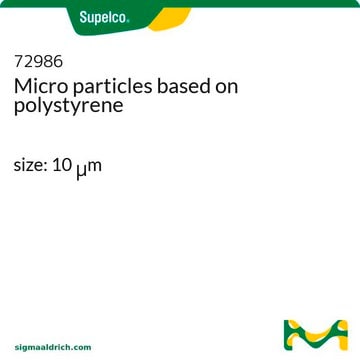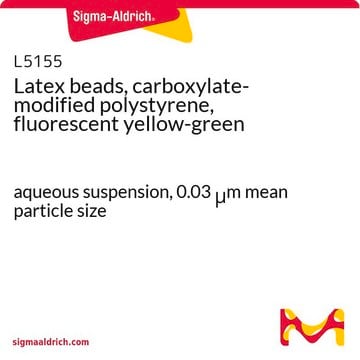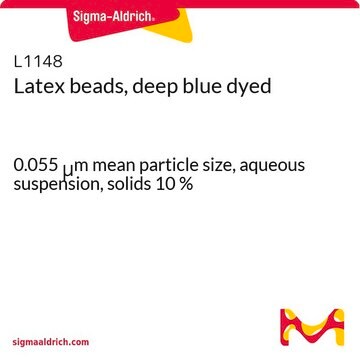LB1
Latex beads, polystyrene
0.1 μm mean particle size
Synonym(s):
Latex Beads, Latex Microspheres
Sign Into View Organizational & Contract Pricing
All Photos(1)
About This Item
Recommended Products
form
aqueous suspension
composition
Solids, 10%
packaging
pack of 1 ea
mean particle size
0.1 μm
Looking for similar products? Visit Product Comparison Guide
General description
Polystyrene microparticles are anionic-stabilizedcolloidal particles. These microparticles are synthesized by the polymerizationof styrene under conditions that produce coalescent bead formation. Polystyrenelatex beads have a wide range of applications including phagocytosis experiments,antibody-mediated agglutination diagnostics, electron microscopy, and cellcounter calibration.
Application
Polystyrene latex beads have been used:
- inthe flow cytometric assay of endothelial microparticles (EMPs)
- in thedetection of capsular polysaccharide (CPS) antibody/antigen latex agglutinationtest
- to evaluate the phagocytic activity in hemocytes of shrimps
Storage Class
10 - Combustible liquids
wgk_germany
WGK 3
flash_point_f
Not applicable
flash_point_c
Not applicable
Certificates of Analysis (COA)
Search for Certificates of Analysis (COA) by entering the products Lot/Batch Number. Lot and Batch Numbers can be found on a product’s label following the words ‘Lot’ or ‘Batch’.
Already Own This Product?
Find documentation for the products that you have recently purchased in the Document Library.
Customers Also Viewed
Evaluation of Cellular Absorption and Metabolism of ??Carotene Loaded in Nanocarriers after In Vitro Digestion
Ling C, et al.
Journal of Agricultural and Food Chemistry, 9383-9394, 69-69 (2021)
The effect of MWCNTs on molar mass in in situ polymerization of styrene and methyl methacrylate
Annala M, et al.
European Polymer Journal, 48(9), 1516-1524 (2012)
Francesca Capetti et al.
Journal of separation science, 43(9-10), 1879-1889 (2020-02-20)
The frankincense resins, secreted from Boswellia species, are an uncommon example of a natural raw material where every class of terpenoids is present in similar proportions. Diterpenoids (serratol, incensole, and incensole acetate) are used to discriminate samples from different species
Steven Mascrez et al.
Analytica chimica acta, 1103, 106-114 (2020-02-23)
Headspace solid-phase microextraction (HS-SPME) is an easy, effective, and selective technique for the extraction of volatiles and semi-volatiles compounds. For the latter, longer equilibration times are needed, which are typically shortened by applying agitation or heating the sample. A less
Je-Wen Liou et al.
PloS one, 6(5), e19982-e19982 (2011-05-19)
Recent research shows that visible-light responsive photocatalysts have potential usage in antimicrobial applications. However, the dynamic changes in the damage to photocatalyzed bacteria remain unclear. Facilitated by atomic force microscopy, this study analyzes the visible-light driven photocatalyst-mediated damage of Escherichia
Our team of scientists has experience in all areas of research including Life Science, Material Science, Chemical Synthesis, Chromatography, Analytical and many others.
Contact Technical Service
